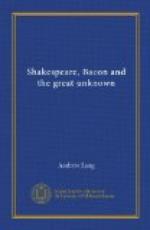Suppose that Will merely supplied Bacon’s plays, under his own name, with a slight difference in spelling, to his company. It was as much his interest, in that case, to protest when Bacon’s pen-name was taken in vain, as if he had spelled his own surname with an A in the second syllable.
There is another instance which Mr. Greenwood discusses twice. {37a} In 1599 Jaggard published “The Passionate Pilgrim; W. Shakespeare.” Out of twenty poems, five only were by W. S. In 1612, Jaggard added two poems by Tom Heywood, retaining W. Shakespeare’s name as sole author. “Heywood protested” in print, “and stated that Shakespeare was offended, and,” says Mr. Greenwood, “very probably he was so; but as he was, so I conceive, ‘a concealed poet,’ writing under a nom de plume, he seems to have only made known his annoyance through the medium of Heywood.”
If so, Heywood knew who the concealed poet was. Turning to pp. 348, 349, we find Mr. Greenwood repeating the same story, with this addition, that the author of the poems published by Jaggard, “to do himself right, hath since published them in his own name.” That is, W. Shakespeare has since published under his own name such pieces of The Passionate Pilgrim as are his own. “The author, I know,” adds Heywood, “was much offended with Mr. Jaggard that (altogether unknown to him) presumed to make so bold with his name.”
Why was the author so slack when Jaggard, in 1599, published W. S.’s poems with others not by W. S.?
How can anyone explain, by any theory? It was as open to him in 1599 as in 1612 to publish his own pieces under his own name, or pen-name.
“Here we observe,” says Mr. Greenwood, {38a} “that Heywood does nothing to identify ‘the author with the player.’” This is, we shall see, the eternal argument. Why should Heywood, speaking of W. Shakespeare, explain what all the world knew? There was no other W. Shakespeare (with or without the E and A) but one, the actor, in the world of letters of Elizabeth and James. Who the author was Heywood himself has told us, elsewhere: the author was—Will!
But why Shakespeare was so indifferent to the use of his name, or, when he was moved, acted so mildly, it is not for me or anyone to explain. We do not know the nature of the circumstances in detail; we do not know that the poet saw hopes of stopping the sale of the works falsely attributed to him. I do not even feel certain that he had not a finger in some of them. Knowing so little, a more soaring wit than mine might fly to the explanation that “Shakespeare” was the “nom de plume” of Bacon or his unknown equivalent, and that he preferred to “let sleeping dogs lie,” or, as Mr. Greenwood might quote the Latin tag, said ne moveas Camarinam.




